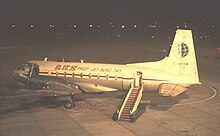Northeast Airlines (UK)
| |||||||
| Founded | February 1952 (as B.K.S. Aero Charter) | ||||||
|---|---|---|---|---|---|---|---|
| Ceased operations | 31 March 1976 (merged into British Airways) | ||||||
| Operating bases | |||||||
| Parent company | British Air Services | ||||||
| Headquarters | Newcastle upon Tyne, England, United Kingdom | ||||||
Northeast Airlines (NEA) – known as BKS Air Transport until 1970 – was an airline based in the United Kingdom that operated from 1952 until 1976, when NEA's operations and fleet were merged into British Airways.
History
BKS





The airline commenced operations in February 1952 from its base at Southend Airport as BKS Aero Charter flying a Douglas C-47 Dakota[1][2][3] (BKS were the founders' initials – i.e. James Barnby, T D 'Mike' Keegan and Cyril Stevens.[4]). After less than one month this initial C-47 was sold (to Iberia Airlines),[citation needed] allowing BKS to purchase two further ex-RAF Dakotas. For a couple of years BKS flew charters and freight until 1953, when it was granted permission to operate scheduled services between Newcastle, the Isle of Man and Jersey. The Dakotas continued in operation with BKS until the last of eight was sold in 1967.[5] The airline's name was changed to BKS Air Transport at the end of 1953.[6]
To expand, three Vickers VC.1 Vikings were acquired in 1955[7] to operate flights to Málaga. The next aircraft type was the pressurised Airspeed Ambassador. It was operated from 1957 and enabled the introduction of longer range scheduled services to Basel, Belfast, Bilbao, Dublin and Santander.
As the network grew, more scheduled flights were added, including Newcastle to London and other routes. In 1958 the Bristol 170 Freighter was added, followed by the Vickers Viscount in 1961. Further expansion in and out of London saw the introduction of the Hawker Siddeley HS 748 in 1962 and the Bristol Britannia in 1964.[8]
By the mid-1960s, London Heathrow had become BKS's busiest operational base with scheduled domestic flights to Leeds/Bradford, Teesside and Newcastle, as well as international scheduled services to Bilbao, Biarritz, and Bordeaux.[4]
The first jet aircraft in the BKS fleet were two Hawker Siddeley Tridents, which were acquired in April 1969. These served the Newcastle-Heathrow route, as well as on inclusive tour charters from Newcastle and London to Mediterranean destinations. Two further Tridents were acquired later.
BKS and Cambrian Airways formed the "British Air Services" group in 1967. British Air Services was a holding company 70% owned by British European Airways and 30% by the former shareholders of BKS and Cambrian.[9]
Northeast Airlines
The airline's name was changed to Northeast Airlines on 1 November 1970. In July 1973, the airline became part of the British Airways group.[10] By 1976 Northeast had been fully integrated into British Airways. The last Northeast flights operated on 31 March 1976.[11]
Historical fleet

- Airspeed Ambassador (five) [12]
- Bristol Britannia (four)
- Bristol 170 Freighter (one)
- Douglas C-47 Dakota (eight)
- Hawker Siddeley HS 748 (five)
- Hawker Siddeley HS.121 Trident (four)
- Vickers VC.1 Viking (three)
- Vickers Viscount 700/800 (twelve)
Accidents and incidents
- On 3 July 1968, BKS Air Transport Flight C.6845 crashed at London Heathrow Airport when a flap actuating rod failed due to metal fatigue. Six of the eight on board and eight horses being transported were killed.[13] Two Hawker Siddeley Tridents were hit by the crashing Ambassador.[14]
- On 17 October 1961, a BKS Dakota (G-AMVC) en route from Yeadon to Crosby, crashed on Croglin Fell in the North Pennines in strong winds, heavy rain and poor visibility. All four crew (the only occupants) were killed.[15]
In literature
BKS Air Transport is featured heavily in the biography Behind the Cockpit Door by Arthur Whitlock, a first officer and subsequent captain who served with the airline for just over two decades. The main section of the book charts the airline's development from its origins at Southend Aerodrome in the early 1950s to its merger with British Airways in the 1970s.
See also
References
- Notes
- ^ Maurice J. Wickstead: Airlines of the British Isles since 1919. Air-Britain (Historians) Ltd., Staplefield, W Sussex 2014, ISBN 978-0-85130-456-4, p. 81.
- ^ Tony Merton Jones: British Independent Airline since 1946, Vol. 3. Merseyside Aviation Society & LAAS International, Liverpool & Uxbridge 1976, ISBN 0 902420 09 7, p. 321.
- ^ "G-AIWE – Registration History". CAA G-INFO. Retrieved 1 March 2024.
- ^ a b "History of BKS". Archived from the original on 24 May 2016. Retrieved 10 June 2009.
- ^ Gradidge, 2006, p. 217
- ^ Merton-Jones 1976, p. 322
- ^ Merton-Jones 1976, p. 323
- ^ Merton-Jones 1976, pp. 330–331
- ^ "Britain's Airline Industry" Flight International 24 October 1968
- ^ Merton-Jones 1976, p. 330
- ^ Hengi, [page needed]
- ^ "G-ALZR, G-ALZT, G-ALZW, G-AMAC, G-AMAD – Registration History". CAA G-INFO. Retrieved 9 March 2024.
- ^ Accident description at the Aviation Safety Network
- ^ Denham 1996, pp. 85, 107
- ^ "1961-10-17|Dakota|G-AMVC|BKS Air Transport Ltd|Croglin Fell, Cumbria". Peak District Air Accident Research. 3 August 2016. Retrieved 23 August 2022.
- Bibliography
- Gradidge, J.M.G. (2006). DC-1, DC-2, DC-3 - The First Seventy Years. Air-Britain (Historians) Ltd. ISBN 0-85130-332-3.
- Hengi, B.I. (2000). Vergangen, Vergessen, Vorbei [Airlines Remembered: Over 200 Airlines of the Past, Described and Illustrated in Colour]. Neil Lewis, translator. Leicester, England: Midland Publishing. ISBN 978-1-85780-091-3.
- Merton-Jones, A.C. (1976). British Independent Airlines since 1946 - Volume 3. Merseyside Aviation Society. ISBN 0-902420-09-7.
- British Airways Archives and Museum Collection (1951–1970)
- Denham, Terry (1996). World Directory of Airliner Crashes. Sparkford: Patrick Stephens Ltd. ISBN 1-85260-554-5.